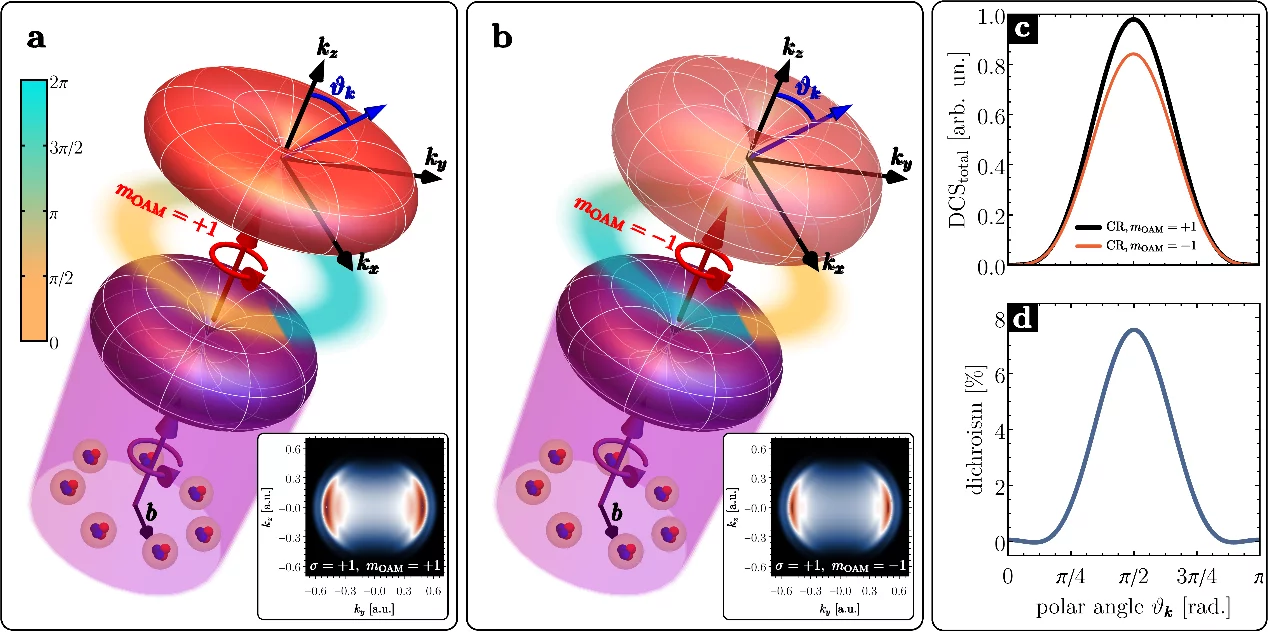Photons have fixed spin and unbounded orbital angular momentum (OAM). While the former is manifested in the polarization of light, the latter corresponds to the spatial phase distribution of its wave front.
The distinctive way in which the photon spin dictates the electron motion upon light-matter interaction is the basis for numerous well-established spectroscopies that reveal the electronic, magnetic and structural properties of matter. In contrast, imprinting OAM on a matter wave, specifically on a propagating electron, is generally considered very challenging and the anticipated effect undetectable. Indeed, this amounts to transferring the phase of a classical electromagnetic wave, defined within several hundreds of nanometres, to a quantum particle localized within the few angstroms of an atom. In addition, the centre of symmetry of irradiated atoms does not in general coincide with the axis of the photon beam.
The generation of X-ray and extreme ultraviolet beams with OAM has been demonstrated in earlier studies. However, a dichroic effect has not yet been detected with such beams. In a joint research effort, an international team of scientists lead by Prof. Giovanni de Ninno (University of Nova Gorica, Elettra Sincrotrone Trieste) now observed an OAM-dependent dichroic effect on photoelectrons released from a sample of He atoms. The experiment was carried out at the LDM beamline of the FERMI free electron laser. The X-ray Optics and Applications group of PSI supported the team with their experience in the creation of OAM beams and during the experiments.
The study predicts theoretically, and confirms experimentally, that the OAM of an optical field can be imprinted coherently onto a propagating electron wave, and that this phase information survives ensemble averaging out to macroscopic distances, where the electron is detected. The team also showed that electronic transitions, which are otherwise optically inaccessible due to selection rules, are essential for this process to occur. The results of this investigation, published recently in Nature Photonics, reveal new aspects of light-matter interaction and point to a new kind of single-photon electron spectroscopy for accessing electronic optical transitions that are usually forbidden by symmetry.
Benedikt Rösner
Laboratory for Advanced Photonics
Paul Scherrer Institut, Forschungstrasse 111, 5232 Villigen PSI, Switzerland
Telephone: +41 56 310 2454, email: benedikt.roesner@psi.ch [English, German]
Photoelectric Effect with a Twist
Giovanni De Ninno, Jonas Wätzel, Primož Rebernik Ribič, Enrico Allaria, Marcello Coreno, Miltcho B. Danailov, Christian David, Alexander Demidovich, Michele Di Fraia, Luca Giannessi, Klavs Hansen, Špela Krušič, Michele Manfredda, Michael Meyer, Andrej Mihelič, Najmeh Mirian, Oksana Plekan, Barbara Ressel, Benedikt Rösner, Alberto Simoncig, Simone Spampinati, Matija Stupar, Matjaž Žitnik, Marco Zangrando, Carlo Callegari, Jamal Berakdar
Nature Photonics 14 (2020), pp. 554-558
DOI: https://doi.org/10.1038/s41566-020-0669-y


